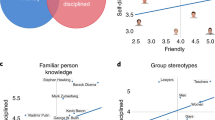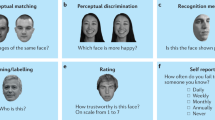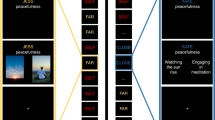Abstract
The concept of domain specificity — which suggests that some aspects of neural processing are specialized for particular types of stimuli — has been invoked to explain a range of cognitive phenomena, including language, face perception and theory of mind, and has been a hallmark of theories of cognitive architecture. More recent usage of this concept draws on neuroscientific data and, in particular, on work in social neuroscience. A critical examination of the part that the concept of domain specificity has played in theories of human brain function leads us to suggest a new view according to which domain specificity pertains to centrally generated constraints on information processing that can be both dynamic and context sensitive.
This is a preview of subscription content, access via your institution
Access options
Access Nature and 54 other Nature Portfolio journals
Get Nature+, our best-value online-access subscription
$29.99 / 30 days
cancel any time
Subscribe to this journal
Receive 12 print issues and online access
$189.00 per year
only $15.75 per issue
Buy this article
- Purchase on Springer Link
- Instant access to full article PDF
Prices may be subject to local taxes which are calculated during checkout

Similar content being viewed by others
References
Van Overwalle, F. A dissociation between social mentalizing and general reasoning. Neuroimage 54, 1589–1599 (2011).
Adolphs, R. The social brain: neural basis of social knowledge. Annu. Rev. Psychol. 60, 693–716 (2009).
Brothers, L. The social brain: a project for integrating primate behavior and neurophysiology in a new domain. Concepts Neurosci. 1, 27–51 (1990).
Dunbar, R. I. The social brain hypothesis. Evol. Anthropol. 9, 178–190 (1998).
Fodor, J. A. The Modularity of Mind: An Essay on Faculty Psychology (MIT Press, 1983).
Barrett, H. C. & Kurzban, R. Modularity in cognition: framing the debate. Psychol. Rev. 113, 628–647 (2006).
Coltheart, M. Modularity and cognition. Trends Cogn. Sci. 3, 115–120 (1999).
Barrett, H. C. Enzymatic computation and cognitive modularity. Mind Language 20, 259–287 (2005).
Barkow, J. H., Cosmides, L. & Tooby, J. (eds) The Adapted Mind: Evolutionary Psychology and the Generation of Culture (Oxford Univ. Press, 1995).
Pinker, S. How the mind works. Ann. NY Acad. Sci. 882, 119–127 (1999).
Carruthers, P. in Contemporary Debates in Cognitive Science (ed. Stainton, R.) 205–225 (Blackwell, 2005).
Deen, B. et al. Organization of high-level visual cortex in human infants. Nat. Commun. 8, 13995 (2017).
Kovacs, A. M., Teglas, E. & Endress, A. D. The social sense: susceptibility to others' beliefs in human infants and adults. Science 330, 1830–1834 (2010).
Weiner, K. S. & Grill-Spector, K. The evolution of face processing networks. Trends Cogn. Sci. 19, 240–241 (2015).
Poldrack, R. A. & Yarkoni, T. From brain maps to cognitive ontologies: informatics and the search for mental structure. Annu. Rev. Psychol. 67, 587–612 (2016).
Poldrack, R. A. Can cognitive processes be inferred from neuroimaging data. Trends Cogn. Sci. 10, 59–63 (2006).
Spunt, R. P. & Adolphs, R. Validating the why/how contrast for functional mri studies of theory of mind. Neuroimage 99, 301–311 (2014).
Saxe, R. Why and how to study theory of mind with fmri. Brain Res. 1079, 57–65 (2006).
Sporns, O. Contributions and challenges for network models in cognitive neuroscience. Nat. Neurosci. 17, 652–660 (2014).
Glasser, M. F. et al. A multi-modal parcellation of human cerebral cortex. Nature 536, 171–178 (2016).
Sporns, O. & Betzel, R. F. Modular brain networks. Annu. Rev. Psychol. 67, 613–640 (2016).
Van Overwalle, F. & Baetens, K. Understanding others' actions and goals by mirror and mentalizing systems: a meta-analysis. Neuroimage 48, 564–584 (2009).
Schaafsma, S. M., Pfaff, D. W., Spunt, R. P. & Adolphs, R. Deconstructing and reconstructing theory of mind. Trends Cogn. Sci. 19, 65–72 (2015).
Schurz, M., Radua, J., Aichhorn, M., Richlan, F. & Perner, J. Fractionating theory of mind: a meta-analysis of functional brain imaging studies. Neurosci. Biobehav. Rev. 42, 9–34 (2014).
Fodor, J. A. The Mind Doesn't Work that Way: The Scope and Limits of Computational Psychology (MIT press, 2001).
Gomez, J. et al. Microstructural proliferation in human cortex is coupled with the development of face processing. Science 355, 68–71 (2017).
Waddington, C. H. Canalization of development and the inheritance of acquired characters. Nature 150, 563–565 (1942).
Gottlieb, G. Experiential canalization of behavioral development: theory. Dev. Psychol. 27, 4–13 (1991).
Del Giudice, M., Manera, V. & Keysers, C. Programmed to learn? The ontogeny of mirror neurons. Dev. Sci. 12, 350–363 (2009).
Schilbach, L. et al. Toward a second-person neuroscience. Behav. Brain Sci. 36, 393–414 (2013).
Heyes, C. M. & Frith, C. D. The cultural evolution of mind reading. Science 344, 1243091 (2014).
Dulac, C. & Torello, A. T. Molecular detection of pheromone signals in mammals: from genes to behaviour. Nat. Rev. Neurosci. 4, 551–562 (2003).
Keverne, E. B. Importance of olfactory and vomeronasal systems for male sexual function. Physiol. Behav. 83, 177–187 (2004).
Menzel, R. & Giurfa, M. Cognitive architecture of a mini-brain: the honeybee. Trends Cogn. Sci. 5, 62–71 (2001).
Kanwisher, N., Mcdermott, J. & Chun, M. M. The fusiform face area: a module in human extrastriate cortex specialized for face perception. J. Neurosci. 17, 4302–4311 (1997).
Tsao, D. Y., Freiwald, W. A., Tootell, R. B. & Livingstone, M. S. A cortical region consisting entirely of face-selective cells. Science 311, 670–674 (2006).
Meyers, E. M., Borzello, M., Freiwald, W. A. & Tsao, D. Intelligent information loss: the coding of facial identity, head pose, and non-face information in the macaque face patch system. J. Neurosci. 35, 7069–7081 (2015).
Afraz, A., Boyden, E. S. & Dicarlo, J. J. Optogenetic and pharmacological suppression of spatial clusters of face neurons reveal their causal role in face gender discrimination. Proc. Natl Acad. Sci. USA 112, 6730–6735 (2015).
Aparicio, P. L., Issa, E. B. & Dicarlo, J. J. Neurophysiological organization of the middle face patch in macaque inferior temporal cortex. J. Neurosci. 36, 12729–12745 (2016).
Saygin, Z. M. et al. Connectivity precedes function in the development of the visual word form area. Nat. Neurosci. 19, 1250–1255 (2016).
Amodio, D. M. & Frith, C. D. Meeting of minds: the medial frontal cortex and social cognition. Nat. Rev. Neurosci. 7, 268–277 (2006).
Spreng, R. N., Mar, R. A. & Kim, A. S. The common neural basis of autobiographical memory, prospection, navigation, theory of mind, and the default mode: a quantitative meta-analysis. J. Cogn. Neurosci. 21, 489–510 (2009).
Heider, F. The Psychology of Interpersonal Relations (John Wiley & Sons, 1958).
Kennedy, D. P. & Adolphs, R. The social brain in psychiatric and neurological disorders. Trends Cogn. Sci. 16, 559–572 (2012).
Herrmann, E., Call, J., Hernàndez-Lloreda, M. V., Hare, B. & Tomasello, M. Humans have evolved specialized skills of social cognition: the cultural intelligence hypothesis. Science 317, 1360–1366 (2007).
Saxe, R. Uniquely human social cognition. Curr. Opin. Neurobiol. 16, 235–239 (2006).
De La Vega, A., Chang, L. J., Banich, M. T., Wager, T. D. & Yarkoni, T. Large-scale meta-analysis of human medial frontal cortex reveals tripartite functional organization. J. Neurosci. 36, 6553–6562 (2016).
Mitchell, J. P. Contributions of functional neuroimaging to the study of social cognition. Curr. Dir. Psychol. Sci. 17, 142–146 (2008).
Sliwa, J. & Freiwald, W. A. A dedicated network for social interaction processing in the primate brain. Science 356, 745–749 (2017).
Schwiedrzik, C. M., Zarco, W., Everling, S. & Freiwald, W. A. Face patch resting state networks link face processing to social cognition. PLoS Biol. 13, e1002245 (2015).
Spunt, R. P. & Lieberman, M. D. An integrative model of the neural systems supporting the comprehension of observed emotional behavior. Neuroimage 59, 3050–3059 (2012).
Cabeza, R. & Moscovitch, M. Memory systems, processing modes, and components: functional neuroimaging evidence. Perspect. Psychol. Sci. 8, 49–55 (2013).
Bukach, C. M., Gauthier, I. & Tarr, M. J. Beyond faces and modularity: the power of an expertise framework. Trends Cogn. Sci. 10, 159–166 (2006).
Lamba, S. & Mace, R. Demography and ecology drive variation in cooperation across human populations. Proc. Natl Acad. Sci. USA 108, 14426–14430 (2011).
Korman, J., Voiklis, J. & Malle, B. F. The social life of cognition. Cognition 135, 30–35 (2015).
Spunt, R. P. & Adolphs, R. Folk explanations of behavior: a specialized use of a domain-general mechanism. Psychol. Sci. 26, 724–736 (2015).
Lauro, L. J., Tettamanti, M., Cappa, S. F. & Papagno, C. Idiom comprehension: a prefrontal task? Cereb. Cortex 18, 162–170 (2008).
Menz, M. M., Blangero, A., Kunze, D. & Binkofski, F. Got it! Understanding the concept of a tool. Neuroimage 51, 1438–1444 (2010).
Satpute, A. B., Badre, D. & Ochsner, K. N. Distinct regions of prefrontal cortex are associated with the controlled retrieval and selection of social information. Cereb. Cortex 24, 1269–1277 (2013).
Barron, H. C., Dolan, R. J. & Behrens, T. E. Online evaluation of novel choices by simultaneous representation of multiple memories. Nat. Neurosci. 16, 1492–1498 (2013).
Kumaran, D., Summerfield, J. J., Hassabis, D. & Maguire, E. A. Tracking the emergence of conceptual knowledge during human decision making. Neuron 63, 889–901 (2009).
Constantinescu, A. O., O'Reilly, J. X. & Behrens, T. E. Organizing conceptual knowledge in humans with a gridlike code. Science 352, 1464–1468 (2016).
Kanwisher, N. Domain specificity in face perception. Nat. Neurosci. 3, 759–763 (2000).
Kanwisher, N. & Yovel, G. The fusiform face area: a cortical region specialized for the perception of faces. Phil. Trans. R. Soc. B 361, 2109–2128 (2006).
Tsao, D. Y. & Livingstone, M. S. Mechanisms of face perception. Annu. Rev. Neurosci. 31, 411–437 (2008).
Logothetis, N. K., Pauls, J., Augath, M., Trinath, T. & Oeltermann, A. Neurophysiological investigation of the basis of the fmri signal. Nature 412, 150–157 (2001).
Anderson, M. L. Neural reuse: a fundamental organizational principle of the brain. Behav. Brain Sci. 33, 245–266 (2010).
Dehaene, S. & Cohen, L. Cultural recycling of cortical maps. Neuron 56, 384–398 (2007).
Gigerenzer, G. & Hug, K. Domain-specific reasoning: social contracts, cheating, and perspective change. Cognition 43, 127–171 (1992).
Karmiloff-Smith, A. Beyond Modularity: A Developmental Perspective on Cognitive Science (MIT press, 1995).
Sternberg, R. J. Domain-generality versus domain-specificity: the life and impending death of a false dichotomy. Merrill-Palmer Quarterly 35, 115–130 (1989).
Insel, T. R. The NIMH Research Domain Criteria (RDoC) Project: precision medicine for psychiatry. Am. J. Psychiatry 171, 395–397 (2014).
Insel, T. et al. Research domain criteria (rdoc): toward a new classification framework for research on mental disorders. Am. J. Psychiatry 167, 748–751 (2010).
Rosch, E. & Lloyd, B. L. Cognition and Categorization (Lawrence Erlbaum Associates, 1978).
Barulli, D. & Stern, Y. Efficiency, capacity, compensation, maintenance, plasticity: emerging concepts in cognitive reserve. Trends Cogn. Sci. 17, 502–509 (2013).
Kolb, B. et al. Experience and the developing prefrontal cortex. Proc. Natl Acad. Sci. USA 109 (Suppl. 2), 17186–17193 (2012).
Mueller, S. et al. Individual variability in functional connectivity architecture of the human brain. Neuron 77, 586–595 (2013).
Damasio, H., Grabowski, T. J., Tranel, D., Hichwa, R. D. & Damasio, A. R. A neural basis for lexical retrieval. Nature 380, 499–505 (1996).
Martin, A., Wiggs, C. L., Ungerleider, L. G. & Haxby, J. V. Neural correlates of category-specific knowledge. Nature 379, 649–652 (1996).
Carrington, S. J. & Bailey, A. J. Are there theory of mind regions in the brain? A review of the neuroimaging literature. Hum. Brain Mapp. 30, 2313–2335 (2009).
Spunt, R. P. & Lieberman, M. D. The busy social brain: evidence for automaticity and control in the neural systems supporting social cognition and action understanding. Psychol. Sci. 24, 80–86 (2013).
Spunt, R. P. & Lieberman, M. D. in Dual-Process Theories of the Social Mind (eds Sherman, J. W., Gawronski, B. & Trope, Y.) 279–299 (Guilford Press, 2014).
Clithero, J. A. & Rangel, A. Informatic parcellation of the network involved in the computation of subjective value. Soc. Cogn. Affect. Neurosci. 9, 1289–1302 (2014).
Downing, P. E., Chan, A. W., Peelen, M. V., Dodds, C. M. & Kanwisher, N. Domain specificity in visual cortex. Cereb. Cortex 16, 1453–1461 (2006).
Saxe, R. & Kanwisher, N. People thinking about thinking people. The role of the temporo-parietal junction in “theory of mind”. Neuroimage 19, 1835–1842 (2003).
Gauthier, I., Tarr, M. J., Anderson, A. W., Skudlarski, P. & Gore, J. C. Activation of the middle fusiform 'face area' increases with expertise in recognizing novel objects. Nat. Neurosci. 2, 568–573 (1999).
Tarr, M. J. & Gauthier, I. FFA: a flexible fusiform area for subordinate-level visual processing automatized by expertise. Nat. Neurosci. 3, 764–769 (2000).
Bilalic, M., Grottenthaler, T., Nägele, T. & Lindig, T. The faces in radiological images: fusiform face area supports radiological expertise. Cereb. Cortex 26, 1004–1014 (2016).
Webster, M. A., Kaping, D., Mizokami, Y. & Duhamel, P. Adaptation to natural facial categories. Nature 428, 557–561 (2004).
Heyes, C. Submentalizing: i am not really reading your mind. Perspect. Psychol. Sci. 9, 131–143 (2014).
Kanwisher, N. Functional specificity in the human brain: a window into the functional architecture of the mind. Proc. Natl Acad. Sci. USA 107, 11163–11170 (2010).
Duchaine, B. C., Dingle, K., Butterworth, E. & Nakayama, K. Normal greeble learning in a severe case of developmental prosopagnosia. Neuron 43, 469–473 (2004).
Acknowledgements
The authors thank members of the Adolphs laboratory for helpful comments. This work was support by National Institute of Mental Health (NIMH) grant 2P50MH094258. The content is solely the responsibility of the authors and does not necessarily represent the official views of the NIMH.
Author information
Authors and Affiliations
Corresponding authors
Ethics declarations
Competing interests
The authors declare no competing financial interests.
PowerPoint slides
Rights and permissions
About this article
Cite this article
Spunt, R., Adolphs, R. A new look at domain specificity: insights from social neuroscience. Nat Rev Neurosci 18, 559–567 (2017). https://doi.org/10.1038/nrn.2017.76
Published:
Issue Date:
DOI: https://doi.org/10.1038/nrn.2017.76
This article is cited by
-
A prefrontal-thalamic circuit encodes social information for social recognition
Nature Communications (2024)
-
The neural basis of naturalistic semantic and social cognition
Scientific Reports (2024)
-
The Skill of Translating Thought into Action: Framing The Problem
Review of Philosophy and Psychology (2021)
-
Beyond the Platonic Brain: facing the challenge of individual differences in function-structure mapping
Synthese (2021)
-
What basic emotions really are: modularity, motivation, and behavioral variability
Biology & Philosophy (2021)



